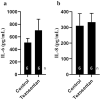Endothelin receptor antagonist improves donor lung function in an ex vivo perfusion system
- PMID: 33008372
- PMCID: PMC7532654
- DOI: 10.1186/s12929-020-00690-7
Endothelin receptor antagonist improves donor lung function in an ex vivo perfusion system
Abstract
Background: A lung transplant is the last resort treatment for many patients with advanced lung disease. The majority of donated lungs come from donors following brain death (BD). The endothelin axis is upregulated in the blood and lung of the donor after BD resulting in systemic inflammation, lung damage and poor lung graft outcomes in the recipient. Tezosentan (endothelin receptor blocker) improves the pulmonary haemodynamic profile; however, it induces adverse effects on other organs at high doses. Application of ex vivo lung perfusion (EVLP) allows the development of organ-specific hormone resuscitation, to maximise and optimise the donor pool. Therefore, we investigate whether the combination of EVLP and tezosentan administration could improve the quality of donor lungs in a clinically relevant 6-h ovine model of brain stem death (BSD).
Methods: After 6 h of BSD, lungs obtained from 12 sheep were divided into two groups, control and tezosentan-treated group, and cannulated for EVLP. The lungs were monitored for 6 h and lung perfusate and tissue samples were processed and analysed. Blood gas variables were measured in perfusate samples as well as total proteins and pro-inflammatory biomarkers, IL-6 and IL-8. Lung tissues were collected at the end of EVLP experiments for histology analysis and wet-dry weight ratio (a measure of oedema).
Results: Our results showed a significant improvement in gas exchange [elevated partial pressure of oxygen (P = 0.02) and reduced partial pressure of carbon dioxide (P = 0.03)] in tezosentan-treated lungs compared to controls. However, the lungs hematoxylin-eosin staining histology results showed minimum lung injuries and there was no difference between both control and tezosentan-treated lungs. Similarly, IL-6 and IL-8 levels in lung perfusate showed no difference between control and tezosentan-treated lungs throughout the EVLP. Histological and tissue analysis showed a non-significant reduction in wet/dry weight ratio in tezosentan-treated lung tissues (P = 0.09) when compared to control.
Conclusions: These data indicate that administration of tezosentan could improve pulmonary gas exchange during EVLP.
Keywords: Brain stem death; EVLP; Endothelin axis; Lung transplantation; Tezosentan.
Conflict of interest statement
The authors declare that they have no competing interests.
Figures





References
-
- Busson M, et al. Donor factors influencing organ transplant prognosis. Transplant Proc. 1995;27(2):1662–1664. - PubMed

